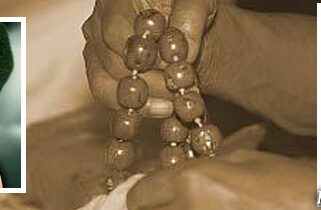26 Other instructions on the practice of the holy name

On Ekadasi day, one should increase one’s chanting of Hare Krsna:
However, one should generally accept the following principles to properly execute devotional service:
(1) take shelter of a bona fide spiritual master,
(2) receive initiation from the spiritual master,
(3) serve the spiritual master,
(4) inquire and learn love from the spiritual master,
(5) follow in the footsteps of holy persons devoted to the transcendental loving service of the Lord,
(6) prepare to give up all kinds of enjoyment and miseries for the satisfaction of krsna,
(7) live in a place where krsna had His pastimes,
(8) be satisfied by whatever is sent by krsna for the maintenance of the body and hanker for no more,
(9) observe fasting on Ekadasiday (this occurs on the eleventh day after the full moon and the eleventh day after the new moon. On such days no grains, cereals or beans are eaten; simply vegetables and milk are moderately taken, and chanting Hare krsna and reading scriptures are increased.),
(10) show respect to devotees, cows and sacred trees like the banyan tree.
On such days no grains, cereals or beans are eaten; simply vegetables and milk are moderately taken, and chanting Hare Krsna and reading scriptures are increased.)
– Teachings of Lord Caitanya
Chanting the holy name before the tulasi plant has immense spiritual potency:
Haridasa thakura constructed a cottage in a solitary forest. There he planted a tulasi plant, and in front of the tulasi he would chant the holy name of the Lord 300,000 times daily. He chanted throughout the entire day and night.
Without difficulty one can sit down anywhere, especially on the bank of the Ganges, Yamuna or any sacred river, devise a sitting place or cottage, plant a tulasi, and before the tulasi chant the Hare Krsna maha mantra undisturbed… the process of chanting the Hare Krsna maha mantra with a vow before the tulasi plant has such great spiritual potency that simply by doing this one can become spiritually strong. Therefore we request the members of the Hare Krsna movement to follow Haridasa thakura’s example rigidly. Chanting sixteen rounds does not take much time, nor is offering respects to the tulasi plant difficult. The process has immense spiritual potency. One should not miss this opportunity.
– Sri Caitanya caritamrta Antya lila 3.100
The more people present at kirtana the better:
In India there are sacred places where yogis go to meditate in solitude, as prescribed in Bhagavad gita. Traditionally, yoga cannot be executed in a public place, but insofar as kirtana−mantra−yoga, or the yoga of chanting the Hare Krsna mantra:
Hare Krsna Hare Krsna Krsna Krsna Hare Hare
Hare Rama Hare Rama Rama Rama Hare Hare
is concerned, the more people present, the better. When Lord Caitanya Mahaprabhu was performing kirtana in India some five hundred years ago, He organized in each group sixteen persons to lead the chanting, and thousands of persons chanted with them.
– The Perfection of Yoga
There Is no need for mental speculation or intellectual adjustment for chanting the maha mantra:
This chanting of the Hare Krsna mantra is enacted from the spiritual platform, and thus this sound vibration surpasses all lower strata of consciousness−namely sensual, mental, and intellectual. There is no need, therefore, to understand the language of the mantra, nor is there any need for mental speculation nor any intellectual adjustment for chanting this maha mantra. It is automatic, from the spiritual platform, and as such, anyone can take part in the chanting without any previous qualification.
– The Science of Self Realization
One may chant the name of the form of the Lord to which one is attracted under the guidance of a pure devotee of that particular form of the Lord (although chanting the name Krsna under the guidance of a pure devotee of Krsna is especially recommended):
The transcendental holy name of the Lord may be heard and chanted accordingly to the attraction of the devotee. One may chant the holy name of Lord Krsna, or one may chant the holy name of Lord Rama or Nrsimhadeva (ramadi−murtisu kala−niyamena tisthan [Bs. 5.39]). The Lord has innumerable forms and names, and devotees may meditate upon a particular form and chant the holy name according to his attraction. The best course is to hear of the holy name, form and so on from a pure devotee of the same standard as oneself. In other words, one who is attached to Krsna should chant and hear from other pure devotees who are also attached to Lord Krsna. The same principle applies for devotees attracted by Lord Rama, Lord Nrsimha and other forms of the Lord. Because Krsna is the ultimate form of the Lord (krsnas tu bhagavan svayam), it is best to hear about Lord Krsna’s name, form and pastimes from a realized devotee who is particularly attracted by the form of Lord Krsna. In Srimad−Bhagavatam, great devotees like Sukadeva Gosvami have specifically described Lord Krsna’s holy name, form and qualities.
– Srimad Bhagavatam 7.5.23−24
If one cannot bathe in water he can bathe by chanting the Hare Krsna mantra:
Pratah−krtya means that one should evacuate regularly and then cleanse himself by taking a bath One has to gargle (acamana) and brush his teeth (danta-dhavana). He should do this either with twigs or a toothbrush — whatever is available. This will purify the mouth. Then one should take his bath. Actually householders and vanaprasthas should bathe two times a day (pratar−madhyahnayoh snanam vanaprastha−grhasthayoh). A sannyasi should bathe three times daily, and a brahmacari may take only one bath a day. Whenever one is not able to bathe in water, he can bathe by chanting the Hare Krsna mantra.
– Sri Caitanya caritamrta Madhya lila 24.331
Twelve names of Lord Visnu should be recited while applying tilaka:
[Lord Caitanya to Sanatana Gosvami]: “When putting the twelve tilaka marks on the twelve places of the body, one has to chant the mantra consisting of these twelve Visnu names. After daily worship, when one anoints the different parts of the body with water, these names should be chanted as one touches each part of the body.”
While marking the body with tilaka, one should chant the following mantra, which consists of the twelve names of Lord Visnu.
lalate kesavam dhyayen narayanam athodare
vaksah−sthale madhavam tu govindam kantha−kupake
visnum ca daksine kuksau bahau ca madhusudanam
trivikramam kandhare tu vamanam vama−parsvake
sridharam vama−bahau tu hrsikesam tu kandhare
prsthe ca padmanabham ca katyam damodaram nyaset
“When one marks the forehead with tilaka, he must remember Kesava. When one marks the lower abdomen, he must remember Narayana. For the chest, one should remember Madhava, and when marking the hollow of the neck one should remember Govinda. Lord Visnu should be remembered while marking the right side of the belly and Madhusudana should be remembered when marking the right arm. Trivikrama should be remembered when marking the right shoulder, and Vamana should be remembered when marking the left side of the belly. Sridhara should be remembered while marking the left arm, and Hrsikesa should be remembered when marking the left shoulder. Padmanabha and Damodara should be remembered when marking the back.”
– Sri Caitanya caritamrta Madhya lila 20.202
One should stamp the holy names of the Lord on his body:
[Lord Caitanya to Sanatana Gosvami]: “In the morning, one should regularly brush his teeth, take his bath, offer prayers to the Lord and offer obeisances to the spiritual master. One should render service to the spiritual master and paint one’s body in twelve places with urdhva−pundra [tilaka]. One should stamp the holy names of the Lord on his body, or one should stamp the symbols of the Lord, such as the disc and club.”
– Sri Caitanya caritamrta Madhya lila 24.332





